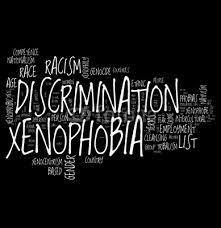Xenophobia v/s Racism: Let’s make a distinction

April 10 2014
Racism or racist behavior is a much flouted term. Every other instance, in a multicultural society, sparks these rows, where people’s approach towards their cultural values becomes rather jingoistic. Oppressors and villains are thus created, and what follows as a consequence, is a generalization, labeling an entire community or country as racist. We have done it too.
The Oxford English dictionary defines racism as thus, “the belief that all members of each race possess characteristics, abilities, or qualities specific to that race, especially so as to distinguish it as inferior or superior to another race or races”; further, elucidating that prejudice, discrimination, or antagonism, directed against someone of a different race, based on the belief that one’s own race is superior, is racism.
Xenophobia on the other hand, is defined as, “involving the relations and perceptions of an in-group towards an out-group, including a fear of losing identity, suspicion of its activities, aggression, and desire to eliminate its presence to secure a presumed purity.
Xenophobia can also be exhibited in the form of an ‘uncritical exaltation of another culture’, in which a culture is ascribed ‘an unreal, stereotyped and exotic quality’. Xenophobia includes a deep-rooted, irrational and unreasonable fear towards foreigners, and the unfamiliar.
James H. Liu and Duncan Mills, in their paper ‘Modern racism and neo-liberal globalization: the discourses of plausible deniability and their multiple functions’ argue how racism has taken more covert forms in a global economy.
“Considerable energy has been focused on extending the mandate of anti-racism… and showing how nationalism is used as a framework for denying racist intent. Analyses of historical context show how ‘race’ forms only one lens from which to view issues of intergroup relations. While the press was sensitive to issues of racism, they demonstrated little awareness of concurrent issues of neo-liberal economics, or market fundamentalism.”
My strain, is on the cause of the two varying expressions; while racism is an expression to be used when distinctions are made, claiming a superior pedestal for oneself, Xenophobia, arises out of an inferiority complex or fear of disruption in the status quo. The two definitely intertwine, but their origins are separate.
Revisiting the two concepts from the perspective of mythological stories, Greco-Roman mythologies prescribe anything that does not conform to the set standards of ‘normal’ as vilified and something to be feared, thereby leading the ‘hero’ to end the threat. An excellent example would be Minotaur, a ‘creature’ with the head of a bull and the body of a man, who was killed by the Athenian hero Theseus. This lens is more likely to create expressions of Xenophobia and not racism, as it arises from a fear of the other.
Chinese dragons are legendary creatures in Chinese mythology and Chinese folklore. The dragons have many animal-like forms such as turtles, fish, and imaginary creatures, but they are most commonly depicted as snake-like with four legs. Traditionally symbolizing potent and auspicious powers, particularly control over water, rainfall, hurricane, and floods. The dragon is also a symbol of power, strength, and good luck for people who are worthy of it. Again, a creature that is not part of the ordinary, or part of the ‘normal’ is held in greater esteem. It is not an object of amusement but special, and praiseworthy.
While a similar figure in Indian mythology, Ganesha, a diety with the head of an elephant is highly revered in the Hindu pantheon. Ganesha’s status as special and praiseworthy even though he is different from the normal, evokes another question. Who gets to serve him from the devotees queuing up, the class distinctions created thus amongst people is more likely to create expressions of caste-ism and further racism, as people assume themselves superior to the other, and the cause is not fear.
The stories we grow up listening to form part of our thought process and comprehension abilities as we decode the world through those lenses and filters.
Suman Fernando, believes equating xenophobia to racism does not solve the problem, it depicts racism as a mere prejudice, which does more harm as it simplifies the problem.
“…Racism is perhaps the most serious basic problem affecting the welfare of people referred to as migrants... Racism is not just about personal racial prejudice but also about institutional processes, ways of thinking and ways of doing things that are deeply ingrained in European culture... equal opportunities in access to a service must be balanced by strict control of institutional racism in the quality of the service and employment practices.”
Racism or racist behavior is a much flouted term. Every other instance, in a multicultural society, sparks these rows, where people’s approach towards their cultural values becomes rather jingoistic. Oppressors and villains are thus created, and what follows as a consequence, is a generalization,...
Racism or racist behavior is a much flouted term. Every other instance, in a multicultural society, sparks these rows, where people’s approach towards their cultural values becomes rather jingoistic. Oppressors and villains are thus created, and what follows as a consequence, is a generalization, labeling an entire community or country as racist. We have done it too.
The Oxford English dictionary defines racism as thus, “the belief that all members of each race possess characteristics, abilities, or qualities specific to that race, especially so as to distinguish it as inferior or superior to another race or races”; further, elucidating that prejudice, discrimination, or antagonism, directed against someone of a different race, based on the belief that one’s own race is superior, is racism.
Xenophobia on the other hand, is defined as, “involving the relations and perceptions of an in-group towards an out-group, including a fear of losing identity, suspicion of its activities, aggression, and desire to eliminate its presence to secure a presumed purity.
Xenophobia can also be exhibited in the form of an ‘uncritical exaltation of another culture’, in which a culture is ascribed ‘an unreal, stereotyped and exotic quality’. Xenophobia includes a deep-rooted, irrational and unreasonable fear towards foreigners, and the unfamiliar.
James H. Liu and Duncan Mills, in their paper ‘Modern racism and neo-liberal globalization: the discourses of plausible deniability and their multiple functions’ argue how racism has taken more covert forms in a global economy.
“Considerable energy has been focused on extending the mandate of anti-racism… and showing how nationalism is used as a framework for denying racist intent. Analyses of historical context show how ‘race’ forms only one lens from which to view issues of intergroup relations. While the press was sensitive to issues of racism, they demonstrated little awareness of concurrent issues of neo-liberal economics, or market fundamentalism.”
My strain, is on the cause of the two varying expressions; while racism is an expression to be used when distinctions are made, claiming a superior pedestal for oneself, Xenophobia, arises out of an inferiority complex or fear of disruption in the status quo. The two definitely intertwine, but their origins are separate.
Revisiting the two concepts from the perspective of mythological stories, Greco-Roman mythologies prescribe anything that does not conform to the set standards of ‘normal’ as vilified and something to be feared, thereby leading the ‘hero’ to end the threat. An excellent example would be Minotaur, a ‘creature’ with the head of a bull and the body of a man, who was killed by the Athenian hero Theseus. This lens is more likely to create expressions of Xenophobia and not racism, as it arises from a fear of the other.
Chinese dragons are legendary creatures in Chinese mythology and Chinese folklore. The dragons have many animal-like forms such as turtles, fish, and imaginary creatures, but they are most commonly depicted as snake-like with four legs. Traditionally symbolizing potent and auspicious powers, particularly control over water, rainfall, hurricane, and floods. The dragon is also a symbol of power, strength, and good luck for people who are worthy of it. Again, a creature that is not part of the ordinary, or part of the ‘normal’ is held in greater esteem. It is not an object of amusement but special, and praiseworthy.
While a similar figure in Indian mythology, Ganesha, a diety with the head of an elephant is highly revered in the Hindu pantheon. Ganesha’s status as special and praiseworthy even though he is different from the normal, evokes another question. Who gets to serve him from the devotees queuing up, the class distinctions created thus amongst people is more likely to create expressions of caste-ism and further racism, as people assume themselves superior to the other, and the cause is not fear.
The stories we grow up listening to form part of our thought process and comprehension abilities as we decode the world through those lenses and filters.
Suman Fernando, believes equating xenophobia to racism does not solve the problem, it depicts racism as a mere prejudice, which does more harm as it simplifies the problem.
“…Racism is perhaps the most serious basic problem affecting the welfare of people referred to as migrants... Racism is not just about personal racial prejudice but also about institutional processes, ways of thinking and ways of doing things that are deeply ingrained in European culture... equal opportunities in access to a service must be balanced by strict control of institutional racism in the quality of the service and employment practices.”









Leave a Comment